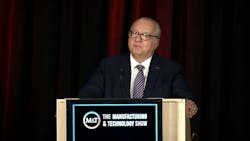So That Happened: US Steel/Cleveland Cliffs in a War of Words
Editor’s note: Welcome to So That Happened, our editors’ takes on things going on in the manufacturing world that deserve some extra attention. This will appear regularly in the Member’s Only section of the site.
Gluing Nuts, Bolts and Screws Together
Adhesives manufacturer H.B. Fuller has acquired the family-owned fastener assemblies materials and services business ND Industries. The acquisition includes 300 employees and five U.S. locations that will operate within H.B. Fuller’s Engineering Adhesives global business unit.
Products under Vibra-Tite, ND Industries’ bottled product division, will be added to H.B. Fuller’s epoxy, cyanoacrylate, UV curable and anaerobic product range.
“ND Industries has been a very profitable, family-owned business for several decades and has impressively built one of the most extensive product portfolios in the pre-applied fastener industry,” says H.B. Fuller President and CEO Celeste Mastin. “Their products are a natural fit with our existing market segments and bring new technology to our portfolio — combining the benefits of an adhesive and a mechanical fastener within extremely demanding applications — resulting in a powerful advantage for our customers.”
This announcement follows several business acquisitions made by H.B. Fuller in 2023, including Adhezion Biomedical, XCHEM International and Beardow Adams.
—Anna Smith
AI Doesn't Take Jobs from Young People; It Gives Them Flashy Résumés
If your business is looking to hire people in Gen Z, you may be reading — and hiring from — resumes written by robots. A survey released May 15 by Resume Templates of almost 3,000 job seekers between 18 and 27 years old found that 22% of that group had used ChatGPT to make their resume or cover letter.
Strikingly, it sounds like it worked: Resume Templates found a whopping 98% of that group reported securing job interviews after posting AI-assisted resumes, 90% said they received job offers, and 52% reported hearing back more often after using the large language model for their applications.
Respondents reported feeding the large language model information like their skills, education and work experience to generate their application materials, and most (77%) were careful enough to edit ChatGPT’s output afterwards.
At least part of the effect might be hiring managers’ interest in the still-novel skill of working with AI. Almost all Gen Z jobseekers who admitted to using AI in job interviews said they believe hiring managers tend to see experience with language models as a plus.
But hiring managers might not feel the same way: 50% of those who admitted using AI on application materials said they were denied a job because they used ChatGPT on an application.
—Ryan Secard
Digitalization, Factory Investment Growing, But It's Not Easy
Investment in factory construction hit a record high of $200 million per month in May 2023 and remained level for the rest of the year, according to a new report from the Manufacturers Alliance Foundation, authored in collaboration with Siemens.
Other report highlights:
- 79% of respondents are already using or rolling out digital twin technology for product planning and development.
- 51% have deployed predictive analytics for supply chain planning.
- 46% have completed projects to integrate robotic automation and AI into manufacturing processes.
- 41% have deployed IoT systems for advanced operational sensing and inventory detection.
According to the report, technology projects are siloed and thus deployment progress is fragmented. It’s easy to launch a pilot program to address a single pain point in single plant, but scaling those pilots to cover multiple challenges at multiple plants is much more difficult. Pilots are also often too complex to scale, especially when they involve plants with legacy infrastructure from multiple vendors.
Finding talent to support digital transformation also remains a huge problem, argues the report. Manufacturers essentially compete with technology companies for the same pool of applicants. Developing digital transformation roadmaps that match long-term business cases also present a significant challenge for manufacturers.
That said, there’s also good news on this front. More than 60% of respondent ssaid their companies have managed to align business cases and digital strategies for supply chain optimization, production efficiency/OEE and data analytics/business intelligence.
To read the full report, “Digitalization Gains: Manufacturers Forge Ahead with Digital Transformation,” go to the Manufacturers Alliance website.
— Dennis Scimeca
Steel Barbs Fly over Nippon Purchase Plan
The saga over one of the year’s biggest potential business combinations continues to drag on.
Nippon Steel Corp.’s nearly $15 billion proposal to buy U.S. Steel Corp. has won the approval of shareholders but is mired in a political morass that includes a requested review by the Committee on Foreign Investment in the United States that could until late this year. (For more on the political jockeying, check out this Council on Foreign Relations brief from earlier this week.)
The public-relations battle around the deal flared up again Tuesday, when the U.S. Steel board said, “Basta!” to feisty rival Lourenco Goncalves, the chairman, president and CEO of Cleveland-Cliffs Inc. (one of the most quotable people in the business world). Goncalves last summer bid to buy U.S. Steel and has since steadfastly said Nippon’s plan can’t be carried out because the United Steelworkers Union has pledged its support to Cliffs. That, Goncalves has reiterated at every opportunity, means Nippon has no legal path to closing on its purchase plan.
Not so, U.S. Steel’s directors said on May 21, calling Goncalves’ statements “a long-running misinformation campaign.” As they have before, they pointed to Nippon leaders’ pledges to take on all USW labor deals and retirement plans as well as invest in growth. But they also acknowledged that their Nippon plan isn’t close to closing.
“We have more to do to get to the finish line and see these benefits come to fruition,” the directors’ collective statement said. “That’s why our management team continues to engage with our employees and community leaders. We are committed to an ongoing and open dialogue to ensure our stakeholders are informed so they can make their own decisions and not fall prey to misinformation.”
Goncalves took barely three hours to publish a response that said U.S. Steel’s board is “attempting to blame Cliffs for its own self-inflicted disaster.” The key piece of supposed misinformation, he said, is that U.S. Steel is asserting that the USW doesn’t have what Cliffs sees as de facto veto power over a company sale.
“With a USW-represented facility, you are not entitled to sell to whomever you please,” Goncalves said. “We knew this, and you apparently did not. We tried to explain to you, but you did not listen to us.”
It’s starting to look like CFIUS (or, in extremis, the White House) will be the only entity everyone will actually listen to—if Nippon has the patience to stick around much longer.
— Geert De Lombaerde
About the Author
Anna Smith
News Editor
News Editor
LinkedIn: https://www.linkedin.com/in/anna-m-smith/
Bio: Anna Smith joined IndustryWeek in 2021. She handles IW’s daily newsletters and breaking news of interest to the manufacturing industry. Anna was previously an editorial assistant at New Equipment Digest, Material Handling & Logistics and other publications.
Ryan Secard
Associate Editor
Ryan Secard joined Endeavor B2B in 2020 as a news editor for IndustryWeek. He currently contributes to IW, American Machinist, Foundry Management & Technology, and Plant Services on breaking manufacturing news, new products, plant openings and closures, and labor issues in manufacturing.
Dennis Scimeca
Dennis Scimeca is a veteran technology journalist with particular experience in vision system technology, machine learning/artificial intelligence, and augmented/mixed/virtual reality (XR), with bylines in consumer, developer, and B2B outlets.
At IndustryWeek, he covers the competitive advantages gained by manufacturers that deploy proven technologies. If you would like to share your story with IndustryWeek, please contact Dennis at [email protected].
Geert De Lombaerde
Senior Editor
A native of Belgium, Geert De Lombaerde has been in business journalism since the mid-1990s and writes about public companies, markets and economic trends for Endeavor Business Media publications, focusing on IndustryWeek, FleetOwner, Oil & Gas Journal, T&D World and Healthcare Innovation. He also curates the twice-monthly Market Moves Strategy newsletter that showcases Endeavor stories on strategy, leadership and investment and contributes to other Market Moves newsletters.
With a degree in journalism from the University of Missouri, he began his reporting career at the Business Courier in Cincinnati in 1997, initially covering retail and the courts before shifting to banking, insurance and investing. He later was managing editor and editor of the Nashville Business Journal before being named editor of the Nashville Post in early 2008. He led a team that helped grow the Post's online traffic more than fivefold before joining Endeavor in September 2021.


